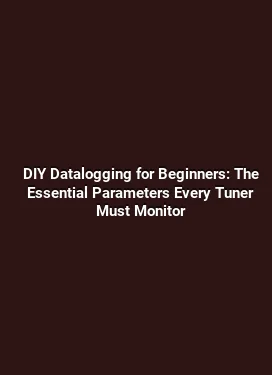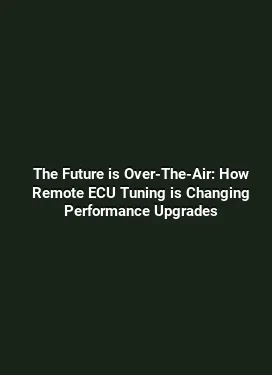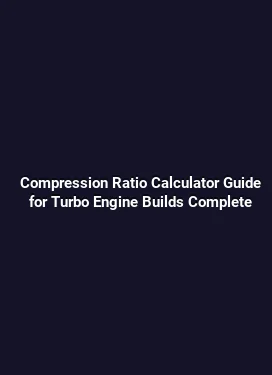WinOLS vs. ECM Titanium: Which ECU Calibration Software Dominates the Tuning Industry?
In the world of engine management and performance tuning, the software tools used to calibrate ECUs are foundational. Two names repeatedly surface in professional workshops and high-end tuning shops are WinOLS and ECM Titanium. Both platforms offer powerful data editing, file management, and mapping capabilities, but their design philosophies, workflows, and resulting outcomes can differ dramatically. This article undertakes a practical, hands-on comparison that focuses on real-world use cases, common pitfalls, and the kind of workstreams that each tool excels at. By exploring data extraction methods, map manipulation approaches, device compatibility, and integration with other workshop processes, technicians can form a grounded view of which solution aligns with their operational goals and skill sets.
Core philosophies: how each tool approaches ECU data

WinOLS has a long-standing reputation for its robust data recognition and project-based workflow. It emphasizes a strong cataloging system for maps, data blocks, and calibration elements, enabling engineers to build structured projects that mirror the layout of the original firmware. Users often appreciate the visual mapping grid, which helps in quickly locating and adjusting critical parameters such as fuel tables, timing, boost control, and lambda corrections. A central theme is the emphasis on organized data management, which reduces the cognitive load when working on complex calibrations across multiple ECU revisions or vehicle platforms.
ECM Titanium, by contrast, has its roots in modular editing workflows that lean on a broad set of importers and export capabilities. It often highlights rapid iteration, batch processing, and a canvas-like environment that allows technicians to compare multiple maps side by side. The software is known for its emphasis on cross-file analysis and data integrity checks, which can be invaluable when tuning platforms with frequent firmware updates or when migrating calibrations between markets with slightly different emission or octane requirements.
Data handling and file management: practical implications for workshops
From a practical standpoint, data handling determines how smoothly a project moves from concept to deployment. WinOLS shines in environments where projects are tightly organized around a single ECU family or manufacturer model. Its project structure supports detailed metadata, including the ECU hardware variant, firmware version, and revision history. This metadata aids traceability when multiple engineers contribute to a single map set or when calibrations must be revisited after a service bulletin or regulatory change. The ability to tag individual maps, annotate changes, and maintain a clear change log can significantly reduce review time during a project handoff.
ECM Titanium emphasizes flexibility in file handling. It provides a suite of import pathways that can accommodate various vendor formats, including bin, hex, and project-based container files. For shops that juggle several vehicle categories—from daily drivers to race vehicles—this flexibility can cut down on pre-processing time. A practical advantage is the ease of creating parallel work streams: engineers can clone a baseline map, apply targeted modifications, and compare results across different operating conditions without reconstructing a project from scratch.
Mapping structures and editing precision

Both tools offer comprehensive mapping capabilities, yet the editing experience can feel different in practice. WinOLS tends to present maps with a focus on accuracy and tactile control. The grid-based editors enable precise navigation to individual cells, which is essential when refining sensor-based feedback loops or small incremental changes in torque and timing. The risk in any precision editing is drift over time; therefore, WinOLS users often rely on built-in validation steps and cross-checks against OEM data to ensure consistency across the entire fuel, ignition, and boost matrices.
ECM Titanium often highlights speed and multi-map comparisons. The user interface is designed to facilitate rapid toggling between related maps, which can accelerate the process of identifying correlated adjustments—such as how a change in boost pressure influences knock-retard margins or how the fueling map interacts with downstream sensor feedback. In practice, technicians benefit from leveraging these side-by-side comparisons when optimizing performance without sacrificing reliability, especially in engines with variable valve timing or complex turbocharger configurations.
Compatibility and ecosystem: hardware, vehicles, and plugins
The scope of supported ECUs, control strategies, and communication interfaces directly impacts a workshop’s capability to service a diverse vehicle roster. WinOLS has extensive coverage, particularly in European markets, with strong integration for certain ECU families and a robust database that veterans in the field rely on for consistent decoding. This can translate into faster recognition of map blocks and more predictable workflows when dealing with legacy ECUs or less common hardware revisions. However, newer platforms may require additional steps or alternative workflows to ensure accurate data interpretation.
ECM Titanium tends to emphasize broad compatibility across a variety of platforms and has built-out mechanisms to handle fresh firmware revisions promptly. The plugin ecosystem and import options often enable engineers to bring in data from multiple sources, including manufacturer stock configurations and third-party data repositories. In practice, this flexibility helps shops standardize tuning operations even when dealing with a mixed fleet, but it can occasionally introduce variability in how maps are decoded if the source data isn’t fully harmonized.
Reliability and version control
Reliable data handling is a non-negotiable requirement for professional tuners. WinOLS’s project-centric approach lends itself to rigorous version control. By encapsulating all related maps, notes, and references within a single project file, teams can trace changes, backport fixes, and manage multiple calibrations for related engine variants without cross-contamination. This structure also supports thorough documentation for compliance and auditing, which is valuable in sanctioned tuning environments.
ECM Titanium’s approach often emphasizes reproducibility and consistency across iterations. Its record-keeping mechanisms help ensure that edits are traceable and that the same sequence of steps can be replicated if a reset is necessary. In high-throughput shops where speed is critical, this reliability reduces the likelihood of accidental changes affecting unrelated maps, particularly when performing bulk adjustments or deploying calibrations across a batch of similar vehicles.
Practical workflows: example scenarios and best practices
Consider a tuning shop that handles a range of turbocharged inline-four engines in European and North American markets. A typical workflow might begin with data extraction from a donor ECU using the chosen tool, followed by decoding core maps such as fuel, ignition timing, boost control, cam phasing, and enable/disable flags. In WinOLS, the engineer might begin by establishing a clean project structure that mirrors the OEM hierarchy, tagging each map with the target operating condition (e.g., high-load vs. cruising) and noting any sensor or actuator id mappings for traceability. This methodical approach facilitates future reuse of map blocks across different vehicle variants and enables straightforward comparison across revisions.
In a parallel workflow using ECM Titanium, the technician could leverage its import and side-by-side comparison features to quickly identify how a modification in the mass airflow sensor calibration cascades into ignition timing and fuel enrichment. Iterations can be executed against multiple baselines to evaluate performance gains and emissions compliance. A practical tip is to establish a standardized set of validation tests—such as 0–60 mph acceleration, reliability under sustained cruise, and knock margin checks—so results are consistently measured across sessions and vehicles.
Both environments benefit from a disciplined change management approach. Establish a naming convention for projects, keep a changelog of notable edits, and maintain a sandbox area where new ideas can be tested without impacting production calibrations. As a rule of thumb, when introducing a calibration change that affects fuel maps, it is prudent to verify sensor feedback loops under a range of weather and octane conditions to avoid reliability issues in the field.
Data integrity and quality control: reducing risk in calibration
Quality control is about preventing unintended consequences. In both systems, a thorough review of data integrity—checking for unassigned memory blocks, ensuring alignment of block sizes with OEM configurations, and validating that units and scaling factors are consistent across maps—reduces risk. WinOLS users commonly use its built-in comparison tools to detect anomalies between the donor data and the target vehicle’s firmware, which helps catch misaligned offsets or swapped coordinate systems early in the workflow. For ECM Titanium, the emphasis on comprehensive data profiling helps identify discrepancies across multiple data layers, such as cross-referencing sensor input ranges with actuator output constraints to ensure a coherent calibration strategy.
For performance-oriented builds, it is essential to avoid drifting away from safe operating envelopes. This means establishing margin buffers in ignition advance and fuel enrichment to accommodate sensor noise, temperature variation, and aging components. In practice, technicians often set up a validation matrix that tests a spectrum of load points, ambient temperatures, and fuel qualities. The results inform whether incremental adjustments should be consolidated into a revision or if further refinement is warranted.
Learning curve and skill development: investing in team capability
Both WinOLS and ECM Titanium reward a systematic learning approach. New users typically benefit from hands-on practice with well-documented example projects, gradually moving from basic map edits to more complex strategies such as targeted timing optimization and turbo boost control. Because the interfaces reflect different design philosophies, personnel with a background in one tool may need a period of acclimation to the other. Structured training that includes guided recipes, validation steps, and real-world troubleshooting scenarios helps accelerate competency and reduces dependence on trial-and-error methods.
Mentorship within a shop can also play a pivotal role. Pairing a veteran who has deep experience with the chosen platform with a newer engineer can accelerate knowledge transfer, especially in areas like data extraction, map correlation, and post-edit verification. As teams grow, establishing a shared library of validated map templates and diagnostic checklists ensures consistency across projects and vehicles.
Choosing the right tool for the operation: criteria to consider
Decision-making should rest on concrete criteria aligned with business goals and technical requirements. Key considerations include the breadth of ECU coverage for the workshop’s typical vehicle mix, the efficiency of the editing workflow, and the quality of data integrity features that minimize risk. For shops that prioritize robust project management and traceability, WinOLS often provides a structured environment that scales well with complex calibration programs. For teams that value rapid iteration, flexible data handling, and easy cross-file analysis, ECM Titanium can offer a workflow that accelerates development cycles without sacrificing reliability.
In practice, many professional tuners adopt a hybrid mindset: selecting a primary platform that best fits the majority of their work while maintaining proficiency in a secondary tool to handle edge cases or specific ECU families. This approach leverages the strengths of each solution and reduces the operational bottlenecks that can arise when relying on a single workflow for all scenarios.
future-proofing and ongoing updates
Access to timely updates and support channels matters as automotive firmware evolves. Evaluate how each platform handles firmware revisions, security patches, and new data formats. A strong update cadence helps ensure that the software remains compatible with the latest ECUs, and reliable vendor support minimizes downtime during critical calibration cycles. Workshops should also consider the availability of community resources, official documentation, and peer networks that can accelerate problem-solving and share proven practices.
Ultimately, the choice between WinOLS and ECM Titanium comes down to how a tuning operation prioritizes structure, speed, and adaptability. For some shops, a meticulous, data-driven workflow with stringent project organization is worth the extra upfront discipline. For others, the ability to rapidly explore new calibrations and manage diverse data streams in a flexible environment delivers greater day-to-day value.
Real-world case considerations: what practitioners report
In practice, technicians report that WinOLS shines when dealing with long-term projects that involve multiple vehicle variants and frequent reference to OEM data blocks. The clarity of the map organization and the strong metadata system improve collaboration across engineers and reduce the risk of misapplication. Practitioners also highlight the importance of disciplined naming conventions and robust change management to keep a team aligned as calibrations scale.
Engineers using ECM Titanium often emphasize the speed of iterative testing and the ability to perform batch edits across multiple files. The platform’s emphasis on layered data analysis and quick map comparisons helps teams identify correlation patterns quickly, which can shorten development cycles for performance-oriented builds. For shops focusing on a mixed fleet, this flexibility can outweigh the need for a heavily structured project framework, especially when throughput is a priority.
Across both tools, the practical value emerges when technicians connect calibration work to measurable performance outcomes, fuel efficiency targets, and reliability benchmarks. The most effective teams establish a disciplined workflow, invest in hands-on practice with representative case studies, and maintain a repository of validated calibration templates that reflect real-world operating conditions.
Key takeaways: aligning software choice with engineering goals
For workshops prioritizing rigorous project governance, traceability, and structured data management, WinOLS offers a dependable framework that supports comprehensive calibration programs across generations of ECUs. For teams that require rapid iteration, cross-platform compatibility, and flexible data handling to manage a diverse vehicle lineup, ECM Titanium provides a versatile environment that can accelerate development cycles while preserving calibration integrity. Both tools deliver substantial value when paired with methodical workflows, meticulous validation, and continuous skill development across the tuning team.
As the tuning landscape evolves with new powertrain technologies, the ability to adapt workflow practices and maintain high-quality calibrations will be the differentiator for professional shops. The choice of software is a strategic decision that should reflect the operational priorities, the typical vehicle mix, and the team's proficiency level, with an eye toward scalable processes that support long-term success.






